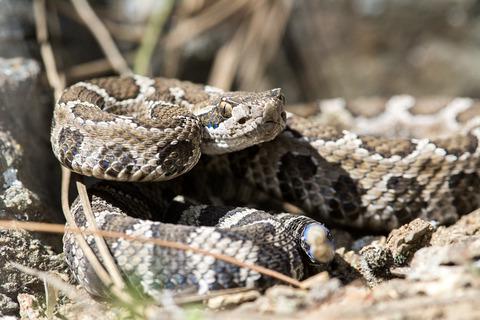当前位置:
X-MOL 学术
›
Ecol. Evol.
›
论文详情
Our official English website, www.x-mol.net, welcomes your feedback! (Note: you will need to create a separate account there.)
Genotyping-in-Thousands by sequencing reveals marked population structure in Western Rattlesnakes to inform conservation status.
Ecology and Evolution ( IF 2.6 ) Pub Date : 2020-06-02 , DOI: 10.1002/ece3.6416 Danielle A Schmidt 1 , Purnima Govindarajulu 2 , Karl W Larsen 3 , Michael A Russello 1
Ecology and Evolution ( IF 2.6 ) Pub Date : 2020-06-02 , DOI: 10.1002/ece3.6416 Danielle A Schmidt 1 , Purnima Govindarajulu 2 , Karl W Larsen 3 , Michael A Russello 1
Affiliation

|
Delineation of units below the species level is critical for prioritizing conservation actions for species at‐risk. Genetic studies play an important role in characterizing patterns of population connectivity and diversity to inform the designation of conservation units, especially for populations that are geographically isolated. The northernmost range margin of Western Rattlesnakes (Crotalus oreganus ) occurs in British Columbia, Canada, where it is federally classified as threatened and restricted to five geographic regions. In these areas, Western Rattlesnakes hibernate (den) communally, raising questions about connectivity within and between den complexes. At present, Western Rattlesnake conservation efforts are hindered by a complete lack of information on genetic structure and degree of isolation at multiple scales, from the den to the regional level. To fill this knowledge gap, we used Genotyping‐in‐Thousands by sequencing (GT‐seq) to genotype an optimized panel of 362 single nucleotide polymorphisms (SNPs) from individual samples (n = 461) collected across the snake's distribution in western Canada and neighboring Washington (USA). Hierarchical STRUCTURE analyses found evidence for population structure within and among the five geographic regions in BC, as well as in Washington. Within these regions, 11 genetically distinct complexes of dens were identified, with some regions having multiple complexes. No significant pattern of isolation‐by‐distance and generally low levels of migration were detected among den complexes across regions. Additionally, snakes within dens generally were more related than those among den complexes within a region, indicating limited movement. Overall, our results suggest that the single, recognized designatable unit for Western Rattlesnakes in Canada should be re‐assessed to proactively focus conservation efforts on preserving total genetic variation detected range‐wide. More broadly, our study demonstrates a novel application of GT‐seq for investigating patterns of diversity in wild populations at multiple scales to better inform conservation management.
中文翻译:

通过测序进行的数千个基因分型揭示了西部响尾蛇明显的种群结构,以告知保护状况。
划定物种水平以下的单位对于优先考虑濒危物种的保护行动至关重要。遗传研究在表征种群连通性和多样性模式方面发挥着重要作用,为保护单位的指定提供信息,特别是对于地理上孤立的种群。西部响尾蛇( Crotalus oreganus )的最北分布范围位于加拿大不列颠哥伦比亚省,联邦将其列为受威胁物种并仅限于五个地理区域。在这些地区,西部响尾蛇集体冬眠(巢穴),引发了有关巢穴内部和巢穴之间连通性的问题。目前,西部响尾蛇的保护工作因完全缺乏从巢穴到区域层面的多个尺度的遗传结构和隔离程度的信息而受到阻碍。为了填补这一知识空白,我们使用数千个测序基因分型 (GT-seq) 对 加拿大西部蛇分布区收集的单个样本 ( n = 461) 进行了 362 个单核苷酸多态性 (SNP) 的优化基因分型。邻近的华盛顿(美国)。层次结构分析发现了不列颠哥伦比亚省以及华盛顿州五个地理区域内部和之间人口结构的证据。在这些区域内,鉴定出 11 个遗传上不同的巢穴复合体,其中一些区域具有多个复合体。在跨区域的巢穴复合体中没有发现明显的距离隔离模式和普遍较低的迁移水平。此外,巢穴内的蛇通常比一个地区内巢穴复合体之间的蛇更相关,这表明运动有限。总的来说,我们的结果表明,应该重新评估加拿大西部响尾蛇的单一、公认的指定单位,以积极主动地将保护工作集中在保护范围内检测到的总遗传变异上。更广泛地说,我们的研究展示了 GT-seq 的一种新颖应用,用于在多个尺度上调查野生种群的多样性模式,以便更好地为保护管理提供信息。
更新日期:2020-07-30
中文翻译:

通过测序进行的数千个基因分型揭示了西部响尾蛇明显的种群结构,以告知保护状况。
划定物种水平以下的单位对于优先考虑濒危物种的保护行动至关重要。遗传研究在表征种群连通性和多样性模式方面发挥着重要作用,为保护单位的指定提供信息,特别是对于地理上孤立的种群。西部响尾蛇( Crotalus oreganus )的最北分布范围位于加拿大不列颠哥伦比亚省,联邦将其列为受威胁物种并仅限于五个地理区域。在这些地区,西部响尾蛇集体冬眠(巢穴),引发了有关巢穴内部和巢穴之间连通性的问题。目前,西部响尾蛇的保护工作因完全缺乏从巢穴到区域层面的多个尺度的遗传结构和隔离程度的信息而受到阻碍。为了填补这一知识空白,我们使用数千个测序基因分型 (GT-seq) 对 加拿大西部蛇分布区收集的单个样本 ( n = 461) 进行了 362 个单核苷酸多态性 (SNP) 的优化基因分型。邻近的华盛顿(美国)。层次结构分析发现了不列颠哥伦比亚省以及华盛顿州五个地理区域内部和之间人口结构的证据。在这些区域内,鉴定出 11 个遗传上不同的巢穴复合体,其中一些区域具有多个复合体。在跨区域的巢穴复合体中没有发现明显的距离隔离模式和普遍较低的迁移水平。此外,巢穴内的蛇通常比一个地区内巢穴复合体之间的蛇更相关,这表明运动有限。总的来说,我们的结果表明,应该重新评估加拿大西部响尾蛇的单一、公认的指定单位,以积极主动地将保护工作集中在保护范围内检测到的总遗传变异上。更广泛地说,我们的研究展示了 GT-seq 的一种新颖应用,用于在多个尺度上调查野生种群的多样性模式,以便更好地为保护管理提供信息。


























 京公网安备 11010802027423号
京公网安备 11010802027423号